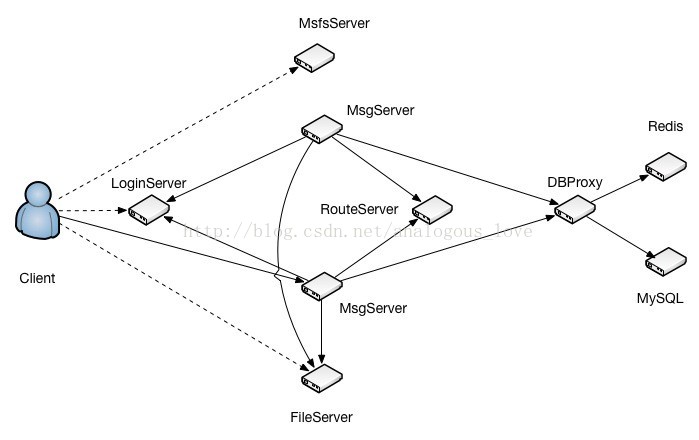07 服务器端msfs源码分析
这篇文章是对TeamTalk服务程序msfs的源码和架构设计分析。msfs作用是用来接受teamtalk聊天中产生的聊天图片的上传和下载。还是老规矩,把该服务在整个架构中的位置图贴一下吧。

可以看到,msfs仅被客户端连接,客户端以http的方式来上传和下载聊天图片。
可能很多同学对http协议不是很熟悉,或者说一知半解。这里大致介绍一下http协议,http协议其实也是一种应用层协议,建立在tcp/ip层之上,其由包头和包体两部分组成(不一定要有包体),看个例子:
比如当我们用浏览器请求一个网址http://www.hootina.org/index.php,实际是浏览器给特定的服务器发送如下数据包,包头部分如下:
GET /index.php HTTP/1.1\r\n
Host: www.hootina.org\r\n
Connection: keep-alive\r\n
Cache-Control: max-age=0\r\n
Accept: text/html,application/xhtml+xml,application/xml;q=0.9,image/webp,/;q=0.8\r\n
User-Agent: Mozilla/5.0\r\n
\r\n
这个包没有包体。
从上面我们可以看出一个http协议大致格式可以描述如下:
GET或Post请求方法 请求的资源路径 http协议版本号\r\n
字段名1:值1\r\n
字段名2:值2\r\n
字段名3:值3\r\n
字段名4:值4\r\n
字段名5:值5\r\n
字段名6:值6\r\n
\r\n
也就是是http协议的头部是一行一行的,每一行以\r\n表示该行结束,最后多出一个空行以\r\n结束表示头部的结束。接下来就是包体的大小了(如果有的话,上文的例子没有包体)。一般get方法会将参数放在请求的资源路径后面,像这样
http://wwww.hootina.org/index.php?变量1=值1&变量2=值2&变量3=值3&变量4=值4
网址后面的问号表示参数开始,每一个参数与参数之间用&隔开
还有一种post的请求方法,这种数据就是将数据放在包体里面了,例如:
POST /otn/login/loginAysnSuggest HTTP/1.1\r\n
Host: kyfw.12306.cn\r\n
Connection: keep-alive\r\n
Content-Length: 96\r\n
Accept: */*\r\n
Origin: https://kyfw.12306.cn\r\n
X-Requested-With: XMLHttpRequest\r\n
User-Agent: Mozilla/5.0 (Windows NT 6.1; WOW64) AppleWebKit/537.36 (KHTML, like Gecko) Chrome/55.0.2883.75\r\n
Content-Type: application/x-www-form-urlencoded; charset=UTF-8\r\n
Referer: https://kyfw.12306.cn/otn/login/init\r\n
Accept-Encoding: gzip, deflate, br\r\n
Accept-Language: zh-CN,zh;q=0.8\r\n
\r\n
loginUserDTO.user_name=balloonwj%40qq.com&userDTO.password=xxxxgjqf&randCode=184%2C55%2C37%2C117
上述报文中loginUserDTO.user_name=balloonwj%40qq.com&userDTO.password=2032_scsgjqf&randCode=184%2C55%2C37%2C117 其实包体内容,这个包是我的一个12306买票软件发给12306服务器的报文。这里拿来做个例子。
因为对方收到http报文的时候,如果包体有内容,那么必须告诉对方包体有多大。这个最常用的就是通过包头的Content-Length字段来指定大小。上面的例子中Content-Length等于96,正好就是字符串 loginUserDTO.user_name=balloonwj%40qq.com&userDTO.password=xxxxgjqf&randCode=184%2C55%2C37%2C117 的长度,也就是包体的大小。
还有一种叫做http chunk的编码技术,通过对http包内容进行分块传输。这里就不介绍了(如果你感兴趣,可以私聊我)。
常见的对http协议有如下几个误解:
html文档的头就是http的头
这种认识是错误的,html文档的头部也是http数据包的包体的一部分。正确的http头是长的像上文介绍的那种。
关于http头Connection:keep-alive字段
一端指定了这个字段后,发http包给另外一端。这个选项只是一种建议性的选项,对端不一定必须采纳,对方也可能在实际实现时,将http连接设置为短连接,即不采纳这个字段的建议。
每个字段都是必须的吗?
不是,大多数字段都不是必须的。但是特定的情况下,某些字段是必须的。比如,通过post发送的数据,就必须设置Content-Length。不然,收包的一端如何知道包体多大。又比如如果你的数据采取了gzip压缩格式,你就必须指定Accept-Encoding: gzip,然对方如何解包你的数据。
好了,http协议就暂且介绍这么多,下面回到正题上来说msfs的源码。
msfs在main函数里面做了如下初始化工作,伪码如下:
//1. 建立一个两个任务队列,分别处理http get请求和post请求
//2. 创建名称为000~255的文件夹,每个文件夹里面会有000~255个子目录,这些目录用于存放聊天图片
//3. 在8700端口上监听客户端连接
//4. 启动程序消息泵
第1点,建立任务队列我们前面系列的文章已经介绍过了。
第2点,代码如下:
g_fileManager = FileManager::getInstance(listen_ip, base_dir, fileCnt, filesPerDir);
int ret = g_fileManager->initDir();
int FileManager::initDir() {
bool isExist = File::isExist(m_disk);
if (!isExist) {
u64 ret = File::mkdirNoRecursion(m_disk);
if (ret) {
log("The dir[%s] set error for code[%d], \
its parent dir may no exists", m_disk, ret);
return -1;
}
}
//255 X 255
char first[10] = {0};
char second[10] = {0};
for (int i = 0; i <= FIRST_DIR_MAX; i++) {
snprintf(first, 5, "%03d", i);
string tmp = string(m_disk) + "/" + string(first);
int code = File::mkdirNoRecursion(tmp.c_str());
if (code && (errno != EEXIST)) {
log("Create dir[%s] error[%d]", tmp.c_str(), errno);
return -1;
}
for (int j = 0; j <= SECOND_DIR_MAX; j++) {
snprintf(second, 5, "%03d", j);
string tmp2 = tmp + "/" + string(second);
code = File::mkdirNoRecursion(tmp2.c_str());
if (code && (errno != EEXIST)) {
log("Create dir[%s] error[%d]", tmp2.c_str(), errno);
return -1;
}
memset(second, 0x0, 10);
}
memset(first, 0x0, 10);
}
return 0;
}
下面,我们直接来看如何处理客户端的http请求,当连接对象CHttpConn收到客户端数据后,调用OnRead方法:
void CHttpConn::OnRead()
{
for (;;)
{
uint32_t free_buf_len = m_in_buf.GetAllocSize()
- m_in_buf.GetWriteOffset();
if (free_buf_len < READ_BUF_SIZE + 1)
m_in_buf.Extend(READ_BUF_SIZE + 1);
int ret = netlib_recv(m_sock_handle,
m_in_buf.GetBuffer() + m_in_buf.GetWriteOffset(),
READ_BUF_SIZE);
if (ret <= 0)
break;
m_in_buf.IncWriteOffset(ret);
m_last_recv_tick = get_tick_count();
}
// 每次请求对应一个HTTP连接,所以读完数据后,不用在同一个连接里面准备读取下个请求
char* in_buf = (char*) m_in_buf.GetBuffer();
uint32_t buf_len = m_in_buf.GetWriteOffset();
in_buf[buf_len] = '\0';
//log("OnRead, buf_len=%u, conn_handle=%u", buf_len, m_conn_handle); // for debug
m_HttpParser.ParseHttpContent(in_buf, buf_len);
if (m_HttpParser.IsReadAll())
{
string strUrl = m_HttpParser.GetUrl();
log("IP:%s access:%s", m_peer_ip.c_str(), strUrl.c_str());
if (strUrl.find("..") != strUrl.npos) {
Close();
return;
}
m_access_host = m_HttpParser.GetHost();
if (m_HttpParser.GetContentLen() > HTTP_UPLOAD_MAX)
{
// file is too big
log("content is too big");
char url[128];
snprintf(url, sizeof(url), "{\"error_code\":1,\"error_msg\": \"上传文件过大\",\"url\":\"\"}");
log("%s",url);
uint32_t content_length = strlen(url);
char pContent[1024];
snprintf(pContent, sizeof(pContent), HTTP_RESPONSE_HTML, content_length,url);
Send(pContent, strlen(pContent));
return;
}
int nContentLen = m_HttpParser.GetContentLen();
char* pContent = NULL;
if(nContentLen != 0)
{
try {
pContent =new char[nContentLen];
memcpy(pContent, m_HttpParser.GetBodyContent(), nContentLen);
}
catch(...)
{
log("not enough memory");
char szResponse[HTTP_RESPONSE_500_LEN + 1];
snprintf(szResponse, HTTP_RESPONSE_500_LEN, "%s", HTTP_RESPONSE_500);
Send(szResponse, HTTP_RESPONSE_500_LEN);
return;
}
}
Request_t request;
request.conn_handle = m_conn_handle;
request.method = m_HttpParser.GetMethod();;
request.nContentLen = nContentLen;
request.pContent = pContent;
request.strAccessHost = m_HttpParser.GetHost();
request.strContentType = m_HttpParser.GetContentType();
request.strUrl = m_HttpParser.GetUrl() + 1;
CHttpTask* pTask = new CHttpTask(request);
if(HTTP_GET == m_HttpParser.GetMethod())
{
g_GetThreadPool.AddTask(pTask);
}
else
{
g_PostThreadPool.AddTask(pTask);
}
}
}
该方法先收取数据,接着解包,然后根据客户端发送的http请求到底是get还是post方法,分别往对应的get和post任务队列中丢一个任务CHttpTask。任务队列开始处理这个任务。我们以get请求的任务为例(Post请求与此类似):
void CHttpTask::run()
{
if(HTTP_GET == m_nMethod)
{
OnDownload();
}
else if(HTTP_POST == m_nMethod)
{
OnUpload();
}
else
{
char* pContent = new char[strlen(HTTP_RESPONSE_403)];
snprintf(pContent, strlen(HTTP_RESPONSE_403), HTTP_RESPONSE_403);
CHttpConn::AddResponsePdu(m_ConnHandle, pContent, strlen(pContent));
}
if(m_pContent != NULL)
{
delete [] m_pContent;
m_pContent = NULL;
}
}
处理任务时,根据请求类型判断到底是客户端下载图片还是上传图片,如果是下载图片则从本机缓存的图片信息中找到该图片,并读取该图片数据,因为是聊天图片,所以一般不会很大,所以这里都是一次性读取图片字节内容,然后发出去。
void CHttpTask::OnDownload()
{
uint32_t nFileSize = 0;
int32_t nTmpSize = 0;
string strPath;
if(g_fileManager->getAbsPathByUrl(m_strUrl, strPath ) == 0)
{
nTmpSize = File::getFileSize((char*)strPath.c_str());
if(nTmpSize != -1)
{
char szResponseHeader[1024];
size_t nPos = strPath.find_last_of(".");
string strType = strPath.substr(nPos + 1, strPath.length() - nPos);
if(strType == "jpg" || strType == "JPG" || strType == "jpeg" || strType == "JPEG" || strType == "png" || strType == "PNG" || strType == "gif" || strType == "GIF")
{
snprintf(szResponseHeader, sizeof(szResponseHeader), HTTP_RESPONSE_IMAGE, nTmpSize, strType.c_str());
}
else
{
snprintf(szResponseHeader,sizeof(szResponseHeader), HTTP_RESPONSE_EXTEND, nTmpSize);
}
int nLen = strlen(szResponseHeader);
char* pContent = new char[nLen + nTmpSize];
memcpy(pContent, szResponseHeader, nLen);
g_fileManager->downloadFileByUrl((char*)m_strUrl.c_str(), pContent + nLen, &nFileSize);
int nTotalLen = nLen + nFileSize;
CHttpConn::AddResponsePdu(m_ConnHandle, pContent, nTotalLen);
}
else
{
int nTotalLen = strlen(HTTP_RESPONSE_404);
char* pContent = new char[nTotalLen];
snprintf(pContent, nTotalLen, HTTP_RESPONSE_404);
CHttpConn::AddResponsePdu(m_ConnHandle, pContent, nTotalLen);
log("File size is invalied\n");
}
}
else
{
int nTotalLen = strlen(HTTP_RESPONSE_500);
char* pContent = new char[nTotalLen];
snprintf(pContent, nTotalLen, HTTP_RESPONSE_500);
CHttpConn::AddResponsePdu(m_ConnHandle, pContent, nTotalLen);
}
}
这里需要说明一下的就是FileManager::getAbsPathByUrl在获取本地文件时,用了一个锁,该锁是为了防止同一个进程同时读取同一个文件,这个锁是“建议性”的,必须自己主动检测有没有上锁:
int FileManager::getAbsPathByUrl(const string &url, string &path) {
string relate;
if (getRelatePathByUrl(url, relate)) {
log("Get path from url[%s] error", url.c_str());
return -1;
}
path = string(m_disk) + relate;
return 0;
}
u64 File::open(bool directIo) {
assert(!m_opened);
int flags = O_RDWR;
#ifdef __linux__
m_file = open64(m_path, flags);
#elif defined(__FREEBSD__) || defined(__APPLE__)
m_file = ::open(m_path, flags);
#endif
if(-1 == m_file) {
return errno;
}
#ifdef __LINUX__
if (directIo)
if (-1 == fcntl(m_file, F_SETFL, O_DIRECT))
return errno;
#endif
struct flock lock;
lock.l_type = F_WRLCK;
lock.l_start = 0;
lock.l_whence = SEEK_SET;
lock.l_len = 0;
if(fcntl(m_file, F_SETLK, &lock) < 0) {
::close(m_file);
return errno;
}
m_opened = true;
u64 size = 0;
u64 code = getSize(&size);
if (code) {
close();
return code;
}
m_size = size;
m_directIo = directIo;
return 0;
}
注意上面的fcntl函数设置的flock锁。这个是linux特有的,应该学习掌握。
图片上传的逻辑和下载逻辑大致类似,这里就不再分析了。
当然,发送图片数据的包和前面的发送逻辑也是一样的,在OnWrite里面发送。发送完毕后会调用CHttpConn::OnSendComplete,在这个函数里面关闭http连接。这也就是说msfs与客户端的http连接也是短连接。
void CHttpConn::OnSendComplete()
{
Close();
}
关于msfs也就这么多内容了。不知道你有没有发现,在搞清楚db_proxy_server和msg_server之后,每个程序框架其实都是一样的,只不过业务逻辑稍微有一点差别。后面介绍的file_server和route_server都是一样的。我们也着重分析其业务代码。
好了,msfs服务就这么多啦。